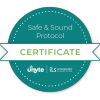Panimus Integration
What is the Safe and Sound Protocol (SSP)
What you hear, and how you hear it, influences how the body responds.
The Safe and Sound Protocol (SSP), developed by Dr. Stephen Porges, is a non-invasive application of Polyvagal Theory designed to reduce stress and auditory sensitivity while enhancing social engagement and resilience.
The SSP is designed to help the nervous system receive, process and respond to the cues and signals from the world around us more effectively. This helps us learn how to more easily and consistently feel better regulated in the face of life’s challenges.
Listening is connected with the vagus nerve, the body’s internal control center for processing and responding to cues and signals from the world around us. The SSP uses specially-filtered music to train the neural network associated with listening to focus on the frequency range of the human voice.
We look, speak and listen with the same system. When the voice changes, the body responds. As we learn to focus on the sound frequencies of human speech through the SSP program, the vagus nerve becomes stimulated and the state of feeling more safe and calm becomes accessible.
The proof is in the playlists. Specially treated music playlists are part of the SSP program and all help ‘prime’ the nervous system by exposing it to different sound frequencies. Listening to these playlists through over the ear headphones helps the nervous system to more readily achieve balance, or “homeostasis.”
There are 3 ways I administer the program, based on the level of support needed, which is based on your reactivity to the Program. The three ways are Standard Support ($650), Minimal Support ($495), and Maximum Support ($895). Most will likely fall in the Minimal or Standard Support category.
The SSP fee through Panimus Integration includes access to the full listening program for 60 days using a custom mobile device app. For continued access beyond 60 days there is a fee of $25 per month. The program is typically completed in 30 to 45 days.
What Headphones Do You Recommend for SSP?
-
Over-the-ear (circumaural) headphones because they allow for an immersive sound experience
-
On-ear headphones and earbuds are not recommended
-
Avoid noise-canceling headphones (unless noise-canceling can be turned off)
-
Avoid headphones with a bass boosting feature, or turn it off.
-
Bluetooth headphones are approved as long as the distance between the headphones and the device is kept to a minimum so as to not disrupt the music.
Therapeutic Considerations
-
Social and emotional difficulties
-
Auditory and other sensory sensitivities
-
Auditory processing difficulties
-
Anxiety and trauma-related challenges
-
Inattention
-
Reactivity
-
Stressors that impact social engagement
-
Difficulties in regulating physiological and emotional state
-
Chronic pain and fatigue
-
Depression
-
Difficulty sleeping
-
Gut issues
-
Low resilience

